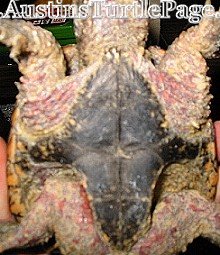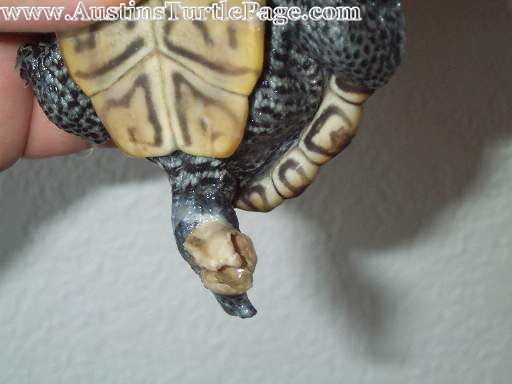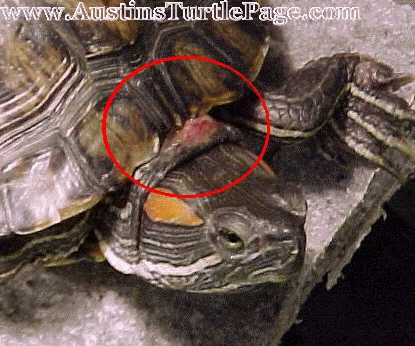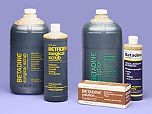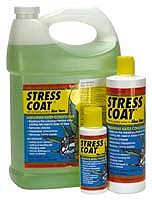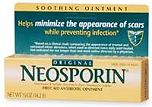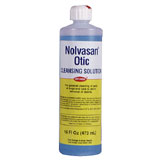|
|
|
|
||
|
If your Turtle experiences any health problems, QUARANTINE them from any other turtles This portion covers the following symptoms and medical situations:
|
||||
|
|
|
|
|
|
|
|
Virtually all animals carry salmonella, no matter the care and
quality of life which they are given. Salmonella is a part of a turtle's gut
flora. They live with having
it, and you can live with them having it...as long as they don't give it to
you! The key factors involved in preventing salmonella poisoning in yourself
and others is quite simple. Proper personal hygiene and quality living
conditions for your turtle. Easy enough? Ensuring that your turtle's habitat,
both land and water, are clean and free of fecal material and food and plant
waste is a giant leap in preventing salmonella from spreading. Another sure
fire way of preventing it from being spread to you or those around you, is to
wash your hand after touching your turtles. It is advised to use an
anti-bacterial soap, like dial, for example. Some argue that turtles are
walking wastelands of salmonella, and that whatever they touch should be
disinfected with strong chemicals and anything not washable should be
discarded, believing that it will eventually spread to either you, your family,
other pets or infest and take over the house, I am not certain. This is the
type of mentality that keeps the sale of turtle illegal in some states and
strict requirements on the size of turtles nation-wide. Granted, at the time,
this was indeed justified, as people kept their little turtle in water they
only changed every so often (ie; when they felt like it), let the turtles live
in waste, both food and feces, kept the little turtle in a plastic green bowl
with a fake palm tree and did not wash their hands after touching them, as well
as well as some children fitting the small turtles in their mouths. Can't blame
the kids...parents are the kuckleheads. Though, today, some let their turtles
and tortoise run freely in their homes, I would personally not recommend it.
But that is STRICTLY a personal preference. Of those keepers I speak with
frequently that practice this type of care, have yet to have problems with
anything other than cleaning up after the turtle or tortoise, as turtles and
tortoise see the world is a great big giant bathroom. Simply maintaining your
turtle in a clean (not sterile) habitat and washing your hands will go a
long way in avoiding any unpleasant exchanges of salmonella. |
||
|
|
|
|
|
|
|
|
This is one of the most common turtle killers in captive care. I have lost a few to this as well. Pneumonia can manifest itself in many of the ways listed below, but there are others I have not listed as they are not as common. Pneumonia is not something you can tell right away. The turtle usually will begin to exhibit sighs, most common of which are listed below, but other times they will carry it for several months without showing any signs or symptoms of being sick. An example: One of my red ear sliders, Frisbee, was fine on Friday evening before we went out of town. Sunday night, he was listing (swimming crooked, one side leaning lower than the other). A week or so later with treatment, he was 100% again and has not had any further problems. On the other hand, Thorn, an Argentine Snakeneck Turtle, showed no signs until near death. Tests were conducted ($$$) by a qualified herp vet (to include Radiographs and CT Scan), who diagnosed the problem as Necrotizing Pneumonia (deteriorating the lung tissue itself). This condition was estimated to have begun almost 1 year prior to showing any signs, and could have continued until death had I not gotten lucky and happen to see Thorn cough of a small amount of lung tissue. After studying the turtle for several hours, I was only able to witness any signs of pneumonia this one time. Rather scary, just ensure that you maintain proper preventative measures. Keep the water temp, ambient air temp and basking temps in a comfortable cushion, as per the needs of that particular species. Ensure that the ambient air temp does not fall below the temp of the water. If it does for a few hours (ie: during the night) then that is normal and natural in the wild. Several cases of pneumonia have been caused by this easily preventable condition. Another way of preventing pneumonia, is to keep the turtles away from drafts, such as under or near open windows, especially in the winter. In our early days, we lost a slider to pneumonia this way.
|
||
|
|
|
|
|
|
|
|
Yes, turtles do cough! Much like in humans, it indicates
some sort of respiratory problem. Underwater, this may look like a
convulsive shock through the system or a wide, long yawn witch a twitching
of the head. While basking, this might sound like a croaking noise from a
frog.
Quarantine and raise all temps in the habitat by 5°. Consult a qualified vet as meds will be needed. |
||
|
|
|
|
|
|
|
|
Yes, turtles do sneeze, too! As stated for coughing, it
indicates some sort of respiratory problem. This may sound like a bird's chirp.
Quarantine and raise all temps in the habitat by 5°. Consult a qualified vet as meds will be needed. |
||
|
|
|
|
|
|
|
|
If your turtle coughs
or 'spits' up material, there is a need for immediate attention, unless it
is food during eating. Turtles may regurgitate their food if they eat too
much too fast, especially if the food items are large (large crickets, large
fish, etc). If the material appears to be white of appears to be like shed
skin, there is a good chance, although not definite, that your turtle has a
lung infection, that could possibly be necrotizing pneumonia. This needs
immediate veterinary assistance. Also take note that this could also be
a sign of Stomatitis (see below).
Quarantine and raise all temps in the habitat by 5°F. Consult a qualified vet ASAP! |
||
|
|
|
|
|
|
|
|
Another name for swimming crooked is listing. This is when one side of the turtle is lower than the other while swimming. This is because there is fluid in one of the lungs, moreso in one than the other, or there is fluid in only one of the lungs. This is usually, although not always, accompanied by one or more of the other listed symptoms of pneumonia. If the turtle can't seem to submerge (usually with the front end trying to swim down but the back end keeps floating) there could be two possibilities. The first is a respiratory infection. The second is a gastrointestinal problem. Problems with the GI system are typical after a regimen of antibiotics. The medicines kill off too much of the gut flora and the turtle begins having difficulty in digesting food. This could be a minimal as the turtle releasing the gas or as severe as needing veterinary treatment. If the situation continues, a vet should be consulted.
|
||
|
|
|
|
|
|
|
|||
Take to qualified vet ASAP. |
|||||
|
|
|
|
|
|
|
|
Mouth rot is an infection in
the mouth of the turtle, either bacterial or viral. Some cases are the results
of herpes-type viral infections, whereas others are, but not limited to,
clamydial and E. coli organisms. Untreated, it can be fatal. It should be noted
that the viral form is highly contagious. Stomatitis can also be found in
the throat. If your turtle is spitting or coughing up material, have the
material tested for Stomatitis as well as a general run-through of lab work.
For
Bacterial Stomatitis, once identified, the
area should be swabbed daily with an iodine or betadine solution. Some gentle
debriding of the area might be needed. Keep turtle in a clean environment and
see veterinary assistance as soon after first discovering this condition.
For Viral Stomatitis, it is difficult to detect viral stomatitis and equally difficult to treat, although not impossible to cure. Most cases, however, are fatal. The turtle should be taken to a vet immediately for treatment. |
||
|
|
|
|
|
|
|
||||||||||||
There are two types of prolapses: Intestinal and penile.
Once this happens, the turtle must be removed from the habitat, as other turtles (as well as the prolapsed turtle itself) my see this as a food item and bite it, causing serious injury and often times, death. Recommended home treatment is to place the animal in a clean, smooth container (I use the bathtub) and coat the prolapse with either granulated sugar (dry sugar, not a water:sugar solution) or honey. This will assist in reducing any swelling and hopefully allow the prolapsed item to be drawn back into the body. It is best to immobilize the turtle to prevent the animal from stepping on it, dragging it, cutting it, or even severing it while it walks and/or struggles. If it goes back in on it's own, that's great. If not, once the swelling has gone down, you can GENTLY try to assist it back into the vent. If you do not feel comfortable with this, it's not working out or you think there is possibly damage to the prolapsed material, then get the turtle to a qualified vet. The vet will assist the animal, sometimes surgically, in returning the intestines to their proper place. At times, removal of a section of the intestinal tract is required, especially if the exposed tract becomes injured. The vet will also suture a purse string to help prevent this from happening again. Penile Prolapse This is sometimes secondary to an existing condition, but sometimes it is just
one of those things that ‘just happens’. When this occurs, the turtle should
be removed immediately if housed with other turtles. I have personally witnessed
one being bitten (yes, ouch) by another turtle, even though it was not in a
prolapse situation. It is not uncommon for turtles to ‘display’ themselves
for short periods of time or times of stressed, so do not be alarmed. At times,
when retracting their organs, they may appear to swat or kick at it while it
withdrawls. This does not mean they are experiencing a prolapse. If it goes back
in, all is good.
With clean hands (preferably sterile gloves, but not everyone has these at their home), lubricate the organ with KY Jelly, and gently attempt to assist the organ back into the turtle. If this fails, as above with the intestinal prolapse, coat the penis with dry, granulated sugar or honey to assist in reducing the swelling. If the penis does not go back in on it's own, you can GENTLY try to assist it back into the vent. If you do not feel comfortable with this, it's not working out or you think there is possibly damage to the prolapsed material, then get the turtle to a qualified vet. Some conditions need some topical medication to assist in returning the prolapse, followed by a suturing which will be removed a few days later. Waiting too long or drastically traumatized organs may require amputation, but this is a very rare case. |
||||||||||||||
|
|
|
|
|
|
|
|
Not all turtles will grow at the same rate, but they should roughly be around the same growth rate. Some things that may inhibit growth: Internal parasites, not eating, improper diet, improper lighting, too cold or sickness. Ensure that the proper temperatures are maintained for that particular species. Also make certain that your UVB light is still emitting UVB waves. Verify that your turtle is indeed eating. This can be done by placing the turtles in separate containers for feedings and count the number of food items placed in with each turtle. If you are providing all of the proper care for your animals and they are not growing, then it indicates some form a health problem, be it sickness or parasites. A trip to a qualified vet is in order. |
||
|
|
|
|
|
|
|
|
There are numerous possibilities why your turtle has either not eaten anything, or has stopped eating. Some possibilities are stress, sickness, aggressive feeding by other turtles, their habitat is too cold, incorrect dietary items, putting food in the wrong place (ie: on land for aquatics) or a variety of other reasons. Fixing the problem requires that you identify the reasons for your turtle's not eating. Some eat well, but will not eat ReptoMin or other floating turtle foods. These types you simply have to work with in getting them to take the prepared food items. Some turtles will go through periods of time where they are perfectly healthy but do not eat. I have a male adult Western Painted that goes 2 weeks of not eating 2-3 times per year. I simply pay more attention to him during this period of time until he begins feeding again to ensure there are no other problems. Also, some turtles will eat less as the days get shorter. This usually only lasts a few weeks or so.
Ensure that the habitat temperatures are prime for your particular species. Try various live foods (worms, crickets, fish) and see if that spurs anything in them. Another method, which is good for trying to get them to eat pellet or stick foods, is to place them in a small container, not much larger then the turtle itself, and place several food sticks/pellets in there with the turtle. This may take a few attempts, but has always proven to be successful. They may start out slowly, but as long as they start eating them, you have your foot in the door. If you take your turtles out to feed in a separate container, and you are finding that some are not willing to eat, then try feeding that turtle in the tank by itself. This has been necessary for only a few of mine, but it seems to work in most cases. Time. Give them time to eat. Just because turtles A, B, C & D start feeding aggressively right away, maybe turtle E needs a little more time for whatever reason. Most of mine begin feeding right away, whereas my Elseya branderhorstis take 10-15 minutes before they even begin looking around for their food (I feed most of mine in separate containers). Try Cichlid Sticks to induce eating. They are really potent in the water, so it seems, as my non-Reptomin eaters would almost always partake of cichlid sticks. Once you get them eating these, start throwing in some ReptoMin. As time goes by, start giving more ReptoMin than Cichlid food. Eventually, they should be completely independent on eating ReptoMin. Make sure that if your turtle is aquatic, that you place their food in the water. Some will identify their food on land and then take it into the water with them to feed on it. Salmon is also another great starter on feeding. Leaves the water oily, but if that is what it takes, then that is what it takes. As for greens and other veggies, I would recommend leaving a large leaf floating in their habitat, allowing them to munch as they wish. Leaving it there, you may start finding that they are feeding on it, just not when you are around to see it. Some are nervous eaters. They don't like you to be there when they eat. My Emydura subglobosa is like that. Sits there underwater until I leave. Peeking in through the door, I can see him eating like crazy. If your turtle just does not eat no matter what you are trying, you will need to get your turtle to a qualified vet soon, as numerous health problems can arise do to not eating (dehydration, vitamin deficiency, etc). |
||
|
|
|
|
|
|
|
|
If your aquatic turtle isn't being aquatic, that's a sign of problems. Commonly, this is a sign of a respiratory infection or other illness and the turtle's health should be investigated. Another sign of your turtle not swimming is that the water temps are not right. Typically, the water is too cold. Sick turtles basking frequently with normally be lethargic and withdrawn into their shell. In a community tank where there are more than 1 turtle, a common problem is aggression. If there is another turtle that is being the neighborhood bully or is aggressively trying to mate, a turtle might be harassed into staying out of the water. If the turtle is otherwise healthy, place the turtle back in the water and watch. See how it interacts with the other turtles. This might take a period of time, but pay attention and watch for signs of fear and/or aggression (ie; turning around and/or swimming away from another turtle). If aggression is not the problem, then check your turtle for other signs or symptoms of illness. |
||
|
|
|
|
|
|
|
|
There are a number of reasons your turtle is not basking. The basking area may be too hot, the water might be too warm, the turtle may not feel safe to bask with you present and may be basking, unbeknownst to you, while you are away, or an illness is present. Something to try is to sneak a peek at them once they have been left alone for a while. By peeking in through the window, I found some of my "never basking map turtles" actually basking, all stretched out and stacked on top of each other. As soon as I walked in, they were back in the water, with no signs of them ever being out. If you find that they definitely are not basking at all, then check the temperature on their basking spot and in their water. If it is too hot, they aren't going to bask, or they may attempt to bask, but not stay there for long. |
||
|
|
|
|
|
|
|
| This is a big indicator of health problems (see 'Not Basking' above). Usually, this is rectified by an adjustment in temperatures. Turtles that are cold will generally sleep a lot. Try raising the temperatures to the specified settings for your species and give it a day. If this does not help, then seek a qualified vet as soon as possible. Also, be alert for other signs or symptoms that could indicate the possible causes/illness. | ||
|
|
|
|
|
|
|
|||
Clean the injured area with clean water. Disinfect the area with iodine or betadine. Treat with Silvadene (Silver Sulfadiazine), Neosporin or triple action antibiotic. Let turtle be dry for about an hour after treatment. Place in separate tank with clean water. You can add StressCoat for fish as it assists in the healing process. Treat this way daily for about 2 weeks or so. |
|||||
|
|
|
|
|
|
|
||||||||||
We recommend keeping the below items on
hand for any type of situation with your turtle:
|
||||||||||||
|
|
|
|
|
